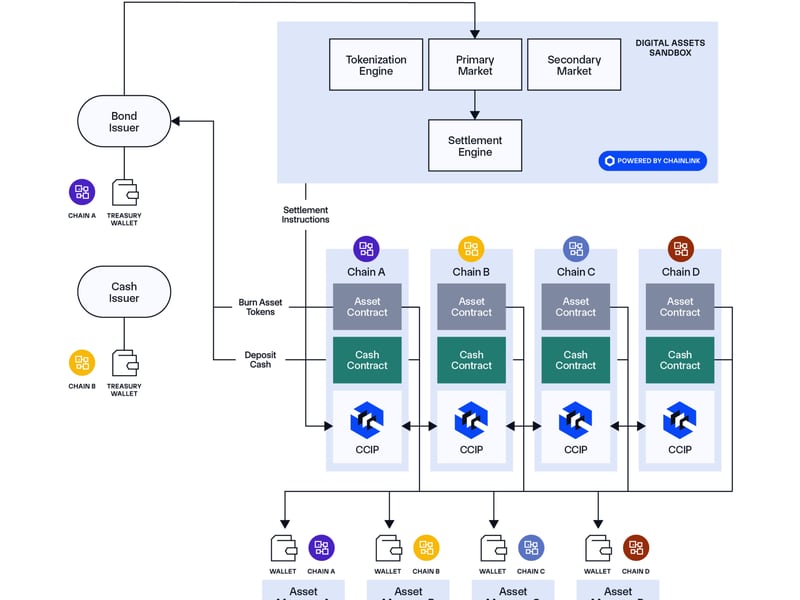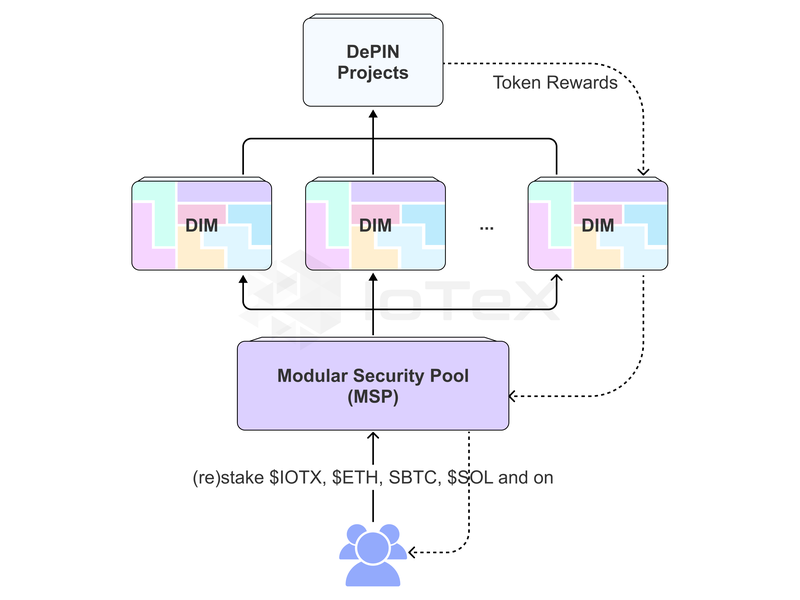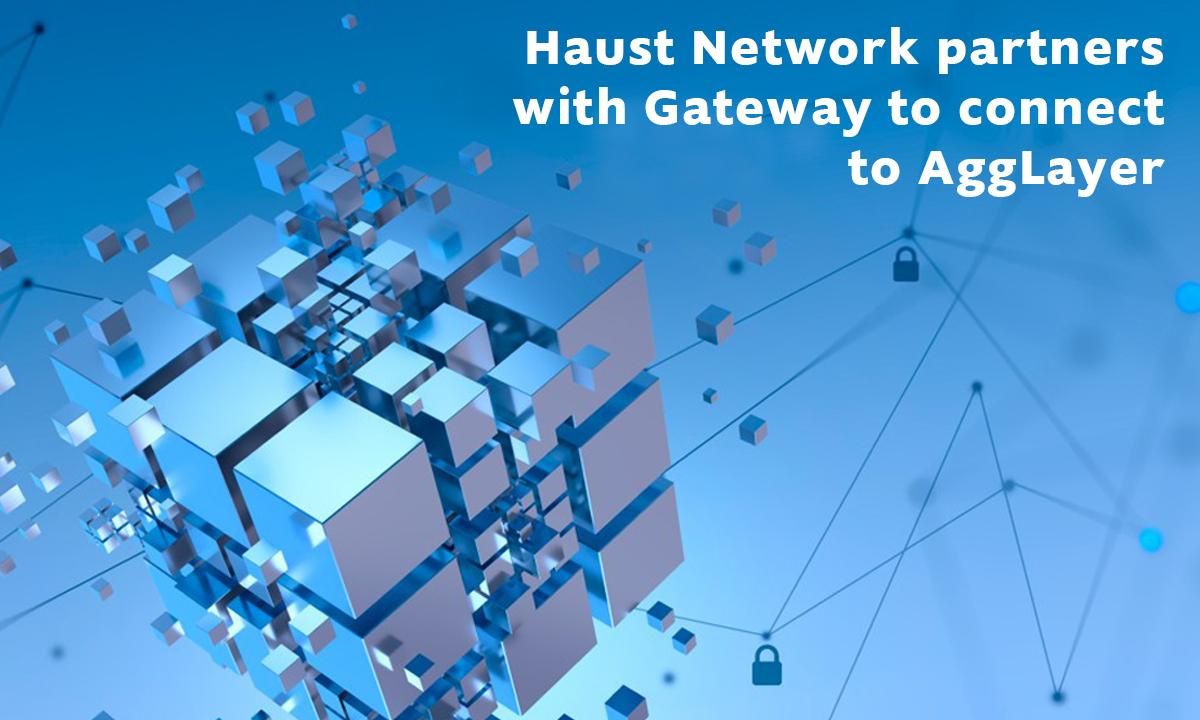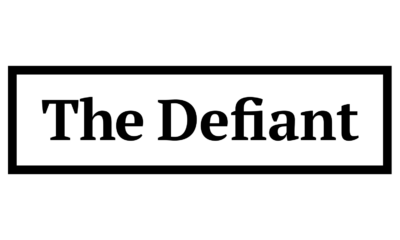DeFi
Protocol Village: Shape, Creator-Focused Ethereum L2 in Optimism Superchain, Makes Testnet Available | Currency News | Financial and Business News

(PROTOCOL VILLAGE EXCLUSIVE) July 18: Shape, a creator-focused layer-2 network atop Ethereum and part of the Optimism Superchain, announced the availability of its testnet, with GA going live in Q3. According to the team: “The network is an open space where everyone is free to create whatever they want – from high art to weird experiments. Shape ensures creators that thrive on the network share in its success through ‘Gasback.’ This mechanic rewards cultural impact directly by giving 80% of sequencer fees back to smart contract owners. Shape is powered by Optimism and, as part of the Superchain, contributes 15% of sequencer fees to the Optimism Collective to fund public goods.”
Chainlink Releases ‘Digital Asset Sandbox’ for Financial Institutions
July 18: Chainlink, the blockchain oracle project, announced the launch of the Chainlink Digital Assets Sandbox (DAS), “designed to accelerate digital asset innovation within financial institutions.” According to the team: “The Chainlink DAS is the ideal solution for financial institutions that want to quickly innovate and experience the potential of generating new revenue opportunities, increasing efficiencies, improving time-to-market, and more. With the DAS, institutions can seamlessly access ready-to-use business workflows for digital assets.” CoinDesk 20 asset: {{LINK}}
Bitrue Ventures Launches $40M Fund for ‘Nascent Web3 Companies’
July 18: Bitrue Ventures, the research and investment section of crypto exchange Bitrue, has launched a $40 million investment fund and “is putting out the call to aspiring developers,” according to the team. A blog post reads: “Individual recipients of funding can receive up to $200,000 of investment funds that can be allocated however they feel is most appropriate. In addition, Bitrue will make available their various avenues of expertise to provide further support to these projects. While Bitrue Ventures will consider investing into any niche within the crypto space, we believe that the most successful projects right now are likely to be building in the sectors of Artificial Intelligence (AI), Real World Asset tokenization (RWA), GameFi, Decentralized Physical Infrastructure Networks (DePIN), and Decentralized Finance (DeFi). As such, projects building within these industries will stand a better chance of receiving funding.”
InfStones, Blockchain Infrastructure Provider, Launches Node-as-a-Service
July 18: InfStones, a blockchain infrastructure provider, “launched its node-as-a-service (NaaS) product, empowering emerging protocols to jumpstart their DePIN projects while making sophisticated blockchain node operations accessible to mainstream users,” according to the team: “Since 2018, InfStones has provided enterprise-grade node management services to industry-leading groups such as Binance, CoinList and BitGo. In the recent node sale for cloud computing platform Aethir, InfStones’ NaaS product helped to successfully convert over 26,000 of its Checker Node license holders into long-term node operators.”
Raise to Provide Payment Rails for Polkadot Mobile App, Enabling Retail Purchases
July 18: Raise, a payments provider and with a white-label gift card infrastructure, has partnered with Parity Technologies “to provide the payment rails for the Polkadot mobile app, enabling DOT payments at over 1 million stores and websites across the U.S.” According to the team: “Users can make purchases and earn up to 20% cash back in DOT. This integration, previewed at Polkadot Decoded, bridges the gap between crypto and retail, making it easier and more rewarding to use crypto for everyday transactions. The app is set to launch in Q3, with plans to expand internationally by the end of the year.” {{DOT}}
Zivoe, RWA Credit Protocol on Ethereum, Raises $8.35M
July 18: Zivoe, a real-world asset credit protocol atop Ethereum, raised $8.35 million in their last round, aiming to broaden credit access by connecting blockchain liquidity with real-world borrowers, according to the team: “The round comes in tandem with Zivoe launching its RWA credit protocol on mainnet on July 31 and their Initial Tranche Offering (ITO), a unique liquidity bootstrapping mechanism.”
AI-Focused Layer-1 Chain Nuklai Announces Launch of DAO for Governance, Say on Use of Funds
July 18: Nuklai, a layer-1 blockchain built for artificial intelligence, announced the launch of the Nuklai DAO, “a decentralized autonomous organization designed to empower its community and ecosystem,” according to the team: “With this development, the company moves towards greater community-driven governance and collaboration. This initiative allows community to have a direct say in the allocation of these funds through proposals and votes on Commonwealth and Snapshot. The launch of the Nuklai DAO will manage the 400,000,000 NAI Community token allocation.”
Polygon, Google Cloud, Accenture Release White Paper on Web3 Loyalty Programs
July 18: Polygon Labs, in collaboration with Google Cloud and Accenture, jointly released a white paper that highlights how Web3 solutions can build high-margin loyalty programs. According to the team: “The paper highlights how users can enjoy rewards such as tokenized privileges, gamification, collectibles and community-generated content. This not only improves the user experience but also generates new revenue streams for brands while empowering users to actively participate in loyalty programs.” {{MATIC}}
Chainbase Raises $15M to Grow Omnichain Data Network
July 18: Omnichain data network Chainbase has raised $15 million in Series A funding with Tencent Investment Group, Matrix Partners and Hash Global among the investors. Chainbase is an interoperability layer that is building the “first crypto world model,” to deliver data from across the cryptocurrency spectrum, according to an emailed announcement on Thursday.
Fantom Foundation, Sonic Labs Partner With Alchemy for RPC on Opera Chain
July 18: The Fantom Foundation and Sonic Labs announced a partnership with Alchemy “in which the leading Web3 infrastructure provider immediately contributes RPC support (mainnet and testnet) and key development tools to developers on Fantom’s Opera chain.” According to the team: “Alchemy will also support the new Sonic network in the same capacity, enhancing its performance and scalability when it launches later this year.”
Outlier Ventures Partnership With Morgan Creek Digital Brings Accelerator to Latin America
July 18: Global Web3 accelerator Outlier Ventures has announced a new strategic partnership with Morgan Creek Digital, to launch their first-ever accelerator program in the Latin American region. According to the team: “The program seeks to identify startups developing solutions to drive technological and financial innovation across Latin America. The virtual program starts in September and lasts for 12 weeks, offering selected startups support from Outlier Ventures’ in-house team of experts, tailored mentorship from industry experts, networking opportunities with investors, and up to 200K investment.”
Visa’s Data Partner Allium Labs Raises $16.5M as Their New Findings Show Stablecoin Activity is Back Up
July 18: Data platform Allium Labs, which provides enterprise-grade blockchain data to companies like Visa, Stripe and Uniswap Foundation, has raised $16.5 million in a Series A funding round, it announced Thursday. The funding round was led by venture capital firm Theory Ventures whose founder Tomasz Tunguz will join the board as part of the investment. Tunguz said “The demand for cryptocurrencies and tokens has just started” and that Allium will provide the data to “foster broader adoption.”
Pundi X Launches Payment Solution for Merchants
July 18: Pundi X, a blockchain developer, has launched a crypto payment solution, Pundi X Pay for merchants, according to the team: “This innovative solution is set to transform the landscape of physical store crypto transactions with the omni QR code payment layer, making it easier for merchants and customers to embrace cryptocurrency payments. Pundi X Pay InStore QR Code features include extensive wallet integrations (over 500+ direct wallet apps), flexible payment options, instant digital receipts, and AI-powered multi-chain transactions and security: powered by Pundi X AI.”
BitGo Integrates Stacks, Enabling Delegate and Solo Stacking
July 18: BitGo has integrated Stacks, “enabling delegate and solo stacking for its clients,” according to the team: “This grants them the ability to earn BTC directly within their wallets via a secure and risk-controlled process. Additionally, BitGo now supports the Stacks token standard and acts as a network Signer, contributing to consensus and block production. This Signer role will be crucial for the future launch of sBTC, a decentralized Bitcoin-backed asset.”
Zeebit, Solana-Based Casino, to Rely on Sonic L2 Infrastructure
July 18: Zeebit, describing itself as “Solana’s first on-chain casino,” is “launching the first fully decentralized risk-on gaming platform on Solana using SonicSVM infrastructure,” according to the team: “This on-chain platform features casino classics, PVP games, and novel Web3 experiences with provable fairness and non-custodial settlement. Leveraging Sonic’s scalable L2, Zeebit will migrate its current Solana-based platform, including player histories. Supported by major Web3 VCs and incubated by Solana Labs, Zeebit’s testnet launch will offer various games, followed by a mainnet launch with incentivized campaigns.”
Aethir, DePIN for GPUs, Teams With Beamable for Cloud-Based Game Development, Distribution
July 18: Aethir, a DePIN project specializing in GPUs for AI and pixel streaming, and Beamable, a creator-centric platform for building live games, announced a “strategic end-to-end solution that will empower game studios to develop, build, scale and distribute live games entirely in the cloud,” according to the team: “With the launch of this end-to-end solution, developers will be able to store, manage, and process data all on one platform to create more engaging and scalable gaming experiences.”
Protocol Village is a regular feature of The Protocol, our weekly newsletter exploring the tech behind crypto, one block at a time. Sign up here to get it in your inbox every Wednesday. Project teams can submit updates here. For previous versions of Protocol Village, please go here. Also please check out our weekly The Protocol podcast.
TON Foundation Says Trustless Bitcoin Bridge for DeFi Launched
July 17: TON Teleport BTC, a trustless bridge facilitating secure bitcoin (BTC) transfers to and from The Open Network (TON) blockchain, has launched. According to a message from the TON Foundation team: “This development enables BTC holders to securely engage in DeFi on TON and participate in decentralized exchanges (DEXs), lending platforms, and other applications. The TON Teleport BTC process is entirely trustless and transparent, operating without a centralized issuer. Each BTC on TON is 100% backed by actual BTC, pegged through the teleport process, ensuring secure and reliable transactions.” {{TON}}
IoTeX ‘DePIN Infrastructure Modules’ to Reduce Development Time
July 17: IoTeX, an Ethereum compatible blockchain platform optimized for decentralized physical infrastructure projects (DePIN), is launching its 2.0 platform to democratize access to DePIN by partnering with NEAR, Filecoin, RISC Zero, Espresso and more, “to enhance data availability, storage, computation and sequencing,” according to the team: “IoTeX 2.0 features DePIN Infrastructure Modules (DIMs) and Modularity Security Pool (MSP) to cut development costs and support sustainable growth for DePIN projects, positioning itself as the largest decentralized hub for devices and data that will be deployed by both humans and AI agents.” According to a press release: “The introduction of Modularity Security Pool (MSP) enables DePIN layer-1s to restake their Proof-of-Stake security to DIMs, fueling growth and fostering sustainability within the ecosystem.”

This story originally appeared on Coindesk
DeFi
Haust Network Partners with Gateway to Connect to AggLayer

Dubai, United Arab Emirates, August 1, 2024, Chainwire
Consumer adoption of cryptocurrencies is a snowball that is accelerating by the day. More and more people around the world are clamoring for access to DeFi. However, the user interface and user experience of cryptocurrencies still lag behind their fundamental utility, and users lack the simple and secure access they need to truly on-chain products.
Haust Network is a network and suite of products focused on changing this paradigm and bringing DeFi to the masses. To achieve this goal, Haust Network has announced its far-reaching partnership with bridgeseasoned veterans in rapidly delivering revolutionary blockchain utilities for projects. The Gateway team empowers blockchain developers to build DAOs, NFT platforms, payment services, and more. They drive adoption of crypto primitives for individuals and institutions around the world by helping everyone build their on-chain presence.
Gateway specializes in connecting sovereign blockchains to the Aggregation Layer (AggLayer). The AggLayer is a single unified contract that powers the Ethereum bridge of many disparate blockchains, allowing them all to connect to a single unified liquidity pool. The AggLayer abstracts away the complexities of cross-chain DeFi, making tedious multi-chain transactions as easy for the end user as a single click. It’s all about creating access to DeFi, and with Polygon’s technology and the help of Gateways, Haust is doing just that.
As part of their partnership, Gateway will build an advanced zkEVM blockchain for Haust Network, leveraging its extensive experience to deploy ultra-fast sovereign applications with unmatched security, and enabling Haust Network to deliver its products to its audience.
The recently announced launch of the Haust Wallet is a Telegram mini-app that provides users with access to DeFi directly through the Telegram interface. Users who deposit funds into the wallet will have access to all standard send/receive services and generate an automatic yield on their funds. The yield is generated by Haust Network’s interconnected network of smart contracts, Haustoria, which provides automated and passive DeFi yielding.
As part of this partnership, the Haust Network development team will work closely with Gateway developers to launch Haust Network. Gateway is an implementation provider for Polygon CDK and zkEVM technology, which the Haust wallet will leverage to deliver advanced DeFi tools directly to the wallet users’ fingertips. Haust’s partnership with Gateway comes shortly after the announcement of a high-profile alliance with the Polygon community. Together, the three will work to build Haust Network and connect its products to the AggLayer.
About Haust Network
Haust Network is an application-based absolute liquidity network and will be built to be compatible with the Ethereum Virtual Machine (EVM). Haust aims to provide native yield to all users’ assets. In Telegram’s Haust Wallet, users can spend and collect their cryptocurrencies in one easy place, at the same time. Haust operates its network of self-balancing smart contracts that interact across multiple blockchains and then efficiently funnel what has been generated to Haust users.
About Gateway
bridge is a leading white-label blockchain provider that offers no-code protocol deployment. Users can launch custom blockchains in just ten minutes. They are an implementation provider for Polygon CDK and have already helped projects like Wirex, Gnosis Pay, and PalmNFT bring new utility to the crypto landscape.
About Polygon Labs
Polygon Laboratories Polygon Labs is a software development company building and developing a network of aggregated blockchains via the AggLayer, secured by Ethereum. As a public infrastructure, the AggLayer will aggregate the user bases and liquidity of any connected chain, and leverage Ethereum as the settlement layer. Polygon Labs has also contributed to the core development of several widely adopted scaling protocols and tools for launching blockchains, including Polygon PoS, Polygon zkEVM, and Polygon Miden, which is currently under development, as well as the Polygon CDK.
Contact
Lana Kovalski
haustnetwork@gmail.com
DeFi
Ethena downplays danger of letting traders use USDe to back risky bets – DL News

- Ethena and ByBit will allow derivatives traders to use USDe as collateral.
- There is a risk in letting traders use an asset partially backed by derivatives to place more bets.
Ethena has downplayed the dangers of a new feature, which will allow traders to put up its synthetic dollar USDe as collateral when trading derivatives, which are risky bets on the prices of crypto assets.
While allowing users to underwrite their trades with yield-bearing USDe is an attractive prospect, Ethena said there is potential risk in letting traders use an asset partially backed by derivatives to place even more derivatives bets.
“We have taken this risk into account and that is why Ethena operates across more than five different sites,” said Conor Ryder, head of research at Ethena Labs. DL News.
The move comes as competition in the stablecoin sector intensifies.
In recent weeks, PayPal grown up the amount of its stablecoin PYUSD in circulation 96%, while the MakerDAO cooperative plans a rebrandingaiming to increase the supply of its DAI stablecoin to 100 billion.
US dollar growth stagnates
It comes as Ethena has lost momentum after its blockbuster launch in December.
In early July, USDe reached a record level of 3.6 billion in circulation.
That figure has now fallen by 11% to around 3.2 billion.
Join the community to receive our latest stories and updates
New uses for USDe could boost demand for Ethena’s products.
This is where the new plan, announcement Tuesday with ByBit, one of its partner exchanges, is coming.
Ethena users create USDe by depositing Bitcoin or Ether into the protocol.
Ethena then covers these deposits with short positions – bearish bets – on the corresponding asset.
This creates a stable support for USDe, unaffected by price fluctuations in Bitcoin or Ether.
Mitigate risks
While using USDe as collateral for derivatives trading is proving popular, it is unclear what the effects will be if the cryptocurrency market experiences major fluctuations.
Using derivatives as collateral to place more bets has already had disastrous effects.
In June 2022, Lido’s liquid staking token stETH broke its peg to Ether following the fallout from the Terra collapse.
Many traders who used looping leverage to increase their stETH staking yields were liquidated, creating a cascade that caused the price of Ether to drop by more than 43%.
Ethena Labs founder Guy Young said: DL News His office and his partners have taken many precautions.
Ethena spreads bearish bets supporting the USDe across the five exchanges it partners with.
According to Ethena, 48% of short positions supporting USDe are on Binance, 23% on ByBit, 20% on OKX, 5% on Deribit, and 1% on Bitget. website.
In doing so, Ethena aims to minimize the impact of an unforeseen event on a stock market.
The same theory applies to the distribution of risks across different supporting assets.
Fifty percent of USDe is backed by Bitcoin, 30% by Ether, 11% by Ether liquid staking tokens, and 8% by Tether’s USDT stablecoin.
Previous reviews
Ethena has already been criticised regarding the risks associated with USDe.
Some have compared USDe to TerraUSD, an undercollateralized stablecoin that collapsed in 2022.
“It’s not a good design for long-term stability,” said Austin Campbell, an assistant professor at Columbia Business School. said as the USDe launch approaches.
Young replied to critics, saying the industry needs to be more diligent and careful when “marketing products to users who might not understand them as well as we do.”
Ethena has since added a disclaimer on its website stating that USDe is not the same as a fiat stablecoin like USDC or USDT.
“This means that the risks involved are inherently different,” the project says on its website.
Tim Craig is DL News DeFi correspondent based in Edinburgh. Feel free to share your tips with us at tim@dlnews.com.
DeFi
Cryptocurrency and defi firms lost $266 million to hackers in July

In July 2024, the cryptocurrency industry suffered a series of devastating attacks, resulting in losses amounting to approximately $266 million.
Blockchain Research Firm Peck Shield revealed in an X post On August 1, attacks on decentralized protocols in July reached $266 million, a 51% increase from $176 million reported in June.
The most significant breach last month involved WazirX, one of India’s largest cryptocurrency exchanges, which lost $230 million in what appears to be a highly sophisticated attack by North Korean hackers. The attack was a major blow to the stock market, leading to a break in withdrawals. Subsequently, WazirX launched a program in order to recover the funds.
Another notable incident involved Compound Finance, a decentralized lending protocol, which suffered a governance attack by a group known as the “Golden Boys,” who passed a proposal who allocated 499,000 COMP tokens – valued at $24 million – to a vault under their control.
The cross-chain liquidity aggregation protocol LI.FI also fell victim On July 16, a hack resulted in losses of $9.73 million. Additionally, Bittensor, a decentralized machine learning network, was one of the first protocols to suffer an exploit last month, loming $8 million on July 3 due to an attack targeting its staking mechanism.
Meanwhile, Rho Markets, a lending protocol, suffered a $7.6 million breach. However, in an interesting twist, the exploiters research to return the stolen funds, claiming the incident was not a hack.
July 31, reports The Terra blockchain protocol was also hacked, resulting in a loss of $6.8 million across multiple cryptocurrencies. As crypto.news reported, the attack exploited a reentrancy vulnerability that had been identified a few months ago.
Dough Finance, a liquidity protocol, lost $1.8 million in Ethereum (ETH) and USD Coin (USDC) to a flash loan attack on July 12. Similarly, Minterest, a lending and borrowing protocol, saw a loss of $1.4 million due to exchange rate manipulation in one of its markets.
Decentralized staking platform MonoSwap also reported a loss of $1.3 million following an attack that allowed the perpetrators to withdraw the liquidity staked on the protocol. Finally, Delta Prime, another decentralized finance platform, suffered a $1 million breach, although $900,000 of the stolen funds was later recovered.
DeFi
The Rise of Bitcoin DeFi: Then and Now

The convergence of Bitcoin’s robust security and Layer 2 scaling solutions has catalyzed the emergence of a vibrant DeFi ecosystem.
By expanding Bitcoin’s utility beyond simple peer-to-peer payments, these advancements have opened up a new frontier of financial possibilities, allowing users to participate in decentralized lending, trading, and other complex smart contract operations on Bitcoin.
Read on to learn about the rise of Bitcoin-based decentralized finance and how the space has expanded to accommodate a new generation of native assets and features.
Note: If you want to learn candlesticks and chart trading from scratch, this is the best book available on Amazon! Get the book now!
What is DeFi?
Decentralized finance (DeFi) represents a paradigm shift in financial services, offering internet-based financial products such as trading, lending, and borrowing through the use of decentralized public blockchains.
By implementing blockchains, smart contracts, and digital assets, DeFi protocols provide financial services through a decentralized ecosystem, where participants do not have to deal with intermediaries when transacting.
What is Bitcoin DeFi?
The inherent limitations of the Bitcoin mainchain in supporting the intricacies of decentralized finance have created the need to develop smart contract-based Layer 2 solutions.
Additionally, the advent of the Ordinals protocol in 2023, which facilitated the emergence of fungible token standards such as BRC-20 and Runes, catalyzed the growth of DeFi on the Bitcoin blockchain.
This expansion in protocol diversity has broadened the applications of the world’s leading cryptocurrency network beyond the core base-layer use cases around value preservation and transactional capabilities.
Therefore, Bitcoin DeFi has become a nascent sector within the digital asset market, after previously being a missing essential part of the Bitcoin ecosystem.
Bitcoin DeFi in its early days
Integrating decentralized finance (DeFi) concepts into the Bitcoin ecosystem has been a journey of innovation and perseverance. Early attempts to bridge the gap between Bitcoin’s fundamental simplicity and DeFi’s complexities have spawned pioneering projects that, while laying essential foundations, have also encountered significant obstacles.
Colored coins
Colored coins represented an early foray into tokenizing real-world assets on the Bitcoin blockchain. By leveraging the existing network to track ownership of assets ranging from stocks to real estate, this approach highlighted Bitcoin’s potential as a platform beyond digital currency. However, scalability and practical implementation challenges have limited its widespread adoption.
Counterpart
Building on the colored coins, Counterparty has become a platform for creating and trading digital assets, including non-fungible tokens (NFTs), on Bitcoin.
The introduction of popular projects like Rare Pepe NFTs has demonstrated the growing appeal of digital collectibles. However, constraints around user experience and network efficiency have hampered its full potential.
These early experiments, while not fully realizing their ambitions, served as valuable stepping stones, informing Bitcoin DeFi’s subsequent developments. Their challenges highlighted the need for more sophisticated infrastructure and protocols to harness the full potential of decentralized finance on the Bitcoin network.
Bitcoin DeFi Today
Today, building DeFi applications on Bitcoin is primarily done in the realm of Layer 2 (L2) networks. This architectural choice is motivated by the limitations of Bitcoin’s base layer in supporting complex programmable smart contracts.
Bitcoin’s original design prioritized security and decentralization over programmability, making it difficult to develop sophisticated DeFi protocols directly on its blockchain. However, the recent emergence of protocols like Ordinals, BRC-20, and Runes, while not DeFi in their own right, has sparked possibilities for future DeFi-like applications on the main chain.
In contrast, L2 solutions offer a scalable and programmable environment built on Bitcoin, enabling the creation of various DeFi products.
By expanding Bitcoin’s capabilities without compromising its core principles, L2s have become the preferred platform for developers looking to build DeFi applications that encompass trading, lending, staking, and more.
Leading L2 networks such as Lightning Network, Rootstock, Stacks, and Build on Bitcoin provide the infrastructure for these efforts. Some of these L2s have even introduced their own native tokens to the network, further expanding Bitcoin’s DeFi ecosystem.
Essentially, while Bitcoin’s core layer presents challenges for DeFi development, its security and decentralization have provided a foundational layer for the innovative L2 landscape to thrive.
Bitcoin Layer 2 offers a promising path to building a robust and thriving Bitcoin-based DeFi ecosystem that offers trading, staking, lending, and borrowing. All you need is a DeFi Wallet like Xverse to access the new world of decentralized financial services secured by Bitcoin.
Conclusion
The integration of DeFi principles into the Bitcoin ecosystem, primarily facilitated by Layer 2 solutions, marks a significant evolution in the digital asset landscape.
Building on the foundational work of pioneers like Colored Coins and Counterparty, the industry has evolved into more sophisticated platforms like Rootstock, Stacks, and Build on Bitcoin to create a thriving Bitcoin-powered DeFi ecosystem.
Advertisement
-

 News1 year ago
News1 year agoBitcoin soars above $63,000 as money flows into new US investment products
-

 DeFi1 year ago
DeFi1 year agoEthena downplays danger of letting traders use USDe to back risky bets – DL News
-

 News1 year ago
News1 year agoFRA Strengthens Cryptocurrency Practice with New Director Thomas Hyun
-

 DeFi1 year ago
DeFi1 year agoZodialtd.com to revolutionize derivatives trading with WEB3 technology
-

 Markets1 year ago
Markets1 year agoBitcoin Fails to Recover from Dovish FOMC Meeting: Why?
-

 DeFi1 year ago
DeFi1 year ago👀 Lido prepares its response to the recovery boom
-

 Markets1 year ago
Markets1 year agoWhale Investments in Bitcoin Reached $100 Billion in 2024, Fueling Crazy Investor Optimism ⋆ ZyCrypto
-

 Markets1 year ago
Markets1 year agoWhy Bitcoin’s price of $100,000 could be closer than ever ⋆ ZyCrypto
-

 DeFi1 year ago
DeFi1 year agoPancakeSwap integrates Zyfi for transparent, gas-free DeFi
-

 Markets1 year ago
Markets1 year agoWhales are targeting these altcoins to make major gains during the bull market 🐋💸
-

 News1 year ago
News1 year agoHow to make $1 million with crypto in just 1 year 💸📈
-

 DeFi1 year ago
DeFi1 year ago🏴☠️ Pump.Fun operated by Insider Exploit







